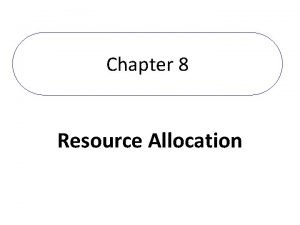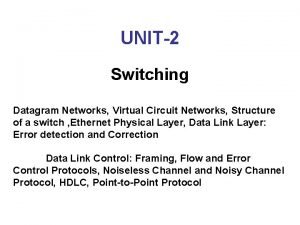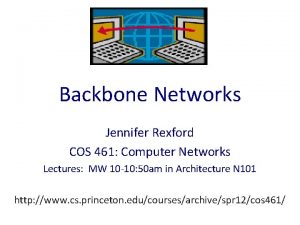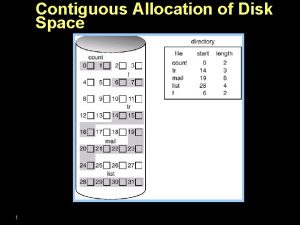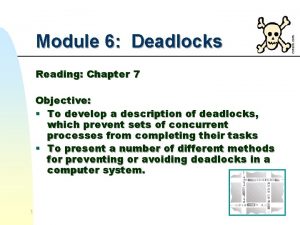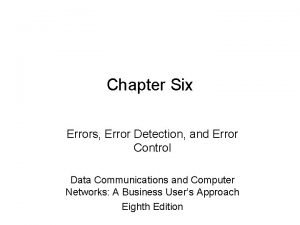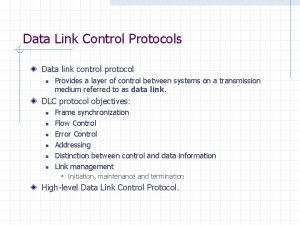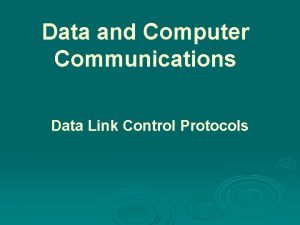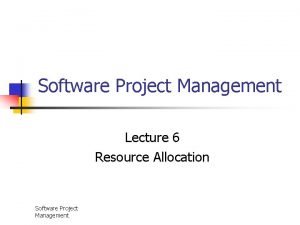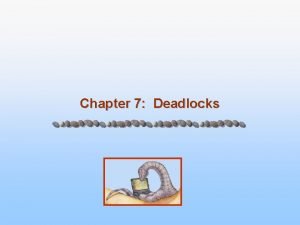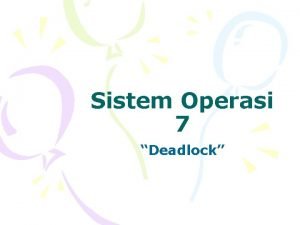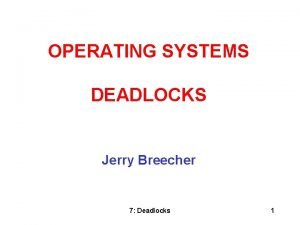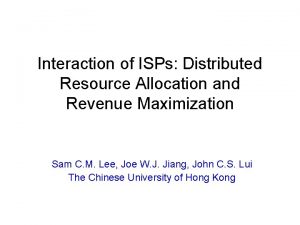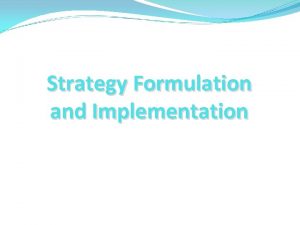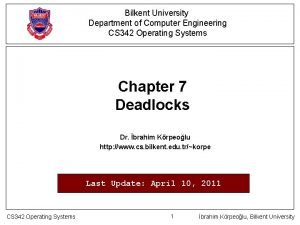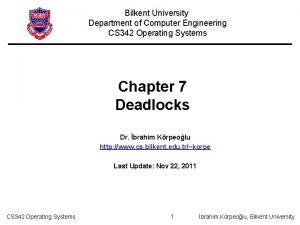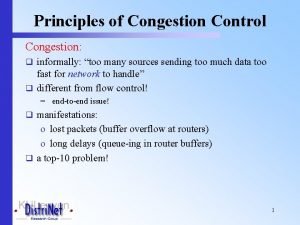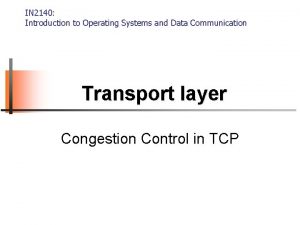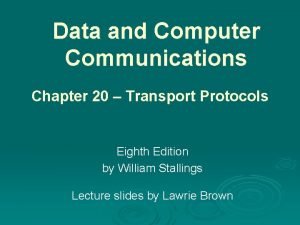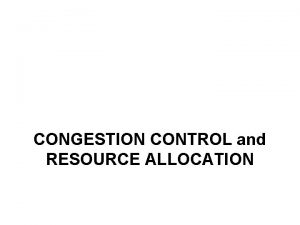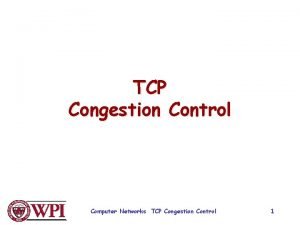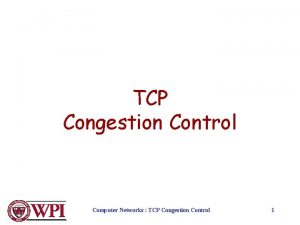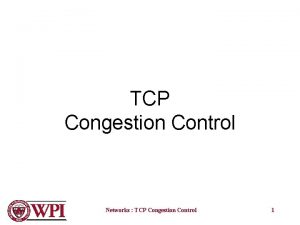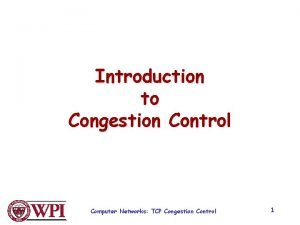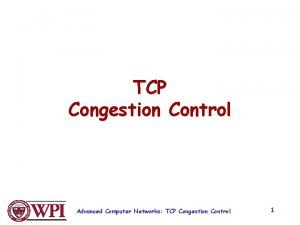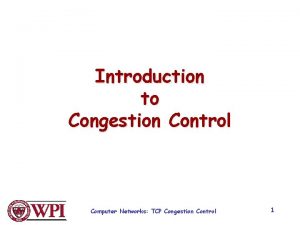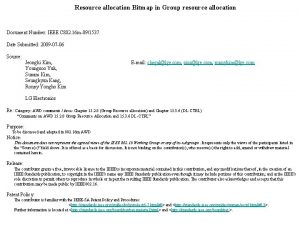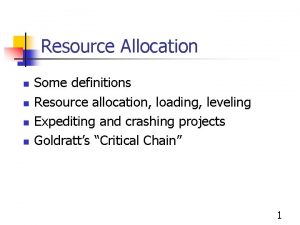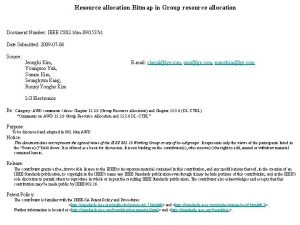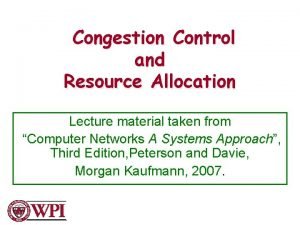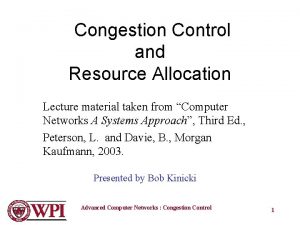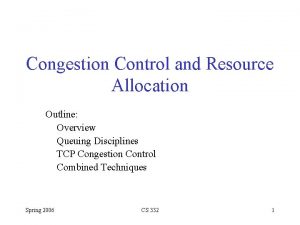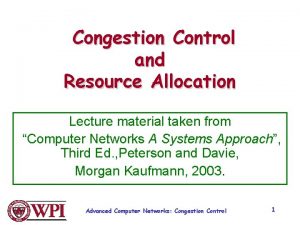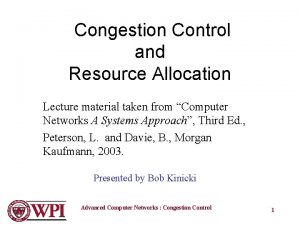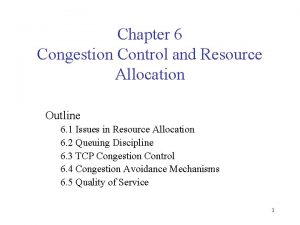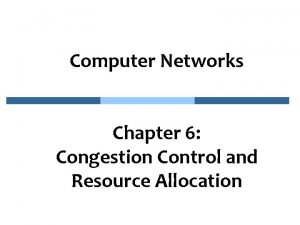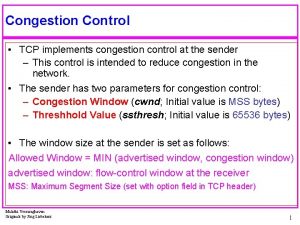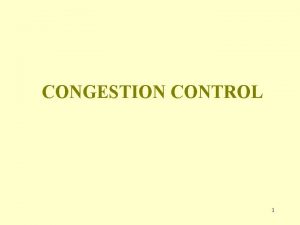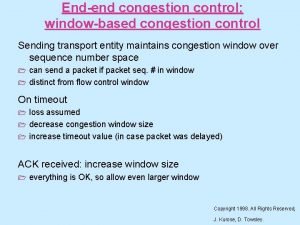Congestion Control and Resource Allocation Computer Networks Congestion

















![Drop Tail Router [FIFO] • First packet to arrive is first to be transmitted. Drop Tail Router [FIFO] • First packet to arrive is first to be transmitted.](https://slidetodoc.com/presentation_image_h/9d9046f6a2c1b1e79cebc525e8340a9b/image-18.jpg)


![Fair Queuing [FQ] • The basic problem with FIFO is that it does not Fair Queuing [FQ] • The basic problem with FIFO is that it does not](https://slidetodoc.com/presentation_image_h/9d9046f6a2c1b1e79cebc525e8340a9b/image-21.jpg)

![Fair Queuing [FQ] • “Ill-behaved” flows are segregated into their own queue. • There Fair Queuing [FQ] • “Ill-behaved” flows are segregated into their own queue. • There](https://slidetodoc.com/presentation_image_h/9d9046f6a2c1b1e79cebc525e8340a9b/image-23.jpg)
![Fair Queuing [FQ] • FQ simulates bit-by-bit behavior by using timestamps (too many details Fair Queuing [FQ] • FQ simulates bit-by-bit behavior by using timestamps (too many details](https://slidetodoc.com/presentation_image_h/9d9046f6a2c1b1e79cebc525e8340a9b/image-24.jpg)
![Weighted Fair Queuing [WFQ] WFQ idea: : Assign a weight to each flow (queue) Weighted Fair Queuing [WFQ] WFQ idea: : Assign a weight to each flow (queue)](https://slidetodoc.com/presentation_image_h/9d9046f6a2c1b1e79cebc525e8340a9b/image-25.jpg)
- Slides: 25

Congestion Control and Resource Allocation Computer Networks : Congestion Control 1

Definitions • Flow control: : keep a fast sender from overrunning a slow receiver. • Congestion control: : the efforts made by network nodes to prevent or respond to overload conditions. Congestion control is intended to keep a fast sender from sending data into the network due to a lack of resources in the network {e. g. , available link capacity, router buffers}. Computer Networks : Congestion Control 2

Congestion Control • Congestion control is concerned with the bottleneck routers in a packet switched network. • Congestion control can be distinguished from routing in that sometimes there is no way to ‘route around’ a congested router. Computer Networks : Congestion Control 3

Congestion 3 6 1 4 8 2 5 Copyright © 2000 The Mc. Graw Hill Copyright © 2000 Companies The Mc. Graw Hill Companies 7 Leon-Garcia & Widjaja: Communication Leon-Garcia & & Widjaja: Communication Networks Leon-Garcia & Widjaja: Communication Networks Computer Networks : Congestion Control Figure 7. 50 b 4

Figure 6. 1 Congestion in a packetswitched network Computer Networks : Congestion Control 5

Flows • flow : : a sequence of packets sent between a source/destination pair and following the same route through the network. • Connectionless flows within the TCP/IP model: : The connection-oriented abstraction, TCP, is implemented at the transport layer while IP provides a connectionless datagram delivery service. • With connectionless flows, there exists no state at the routers. Computer Networks : Congestion Control 6

Flows • Connection-oriented flows (e. g. , X. 25) – connection-oriented networks maintain hard state at the routers. • Soft state : : represents a middle ground where soft state is not always explicitly created and removed by signaling. • Correct operation of the network does not depend on the presence of soft state, but soft state can permit the router to better handle packets. Computer Networks : Congestion Control 7

Figure 6. 2 Multiple Flows passing through a set of routers Computer Networks : Congestion Control 8

Service • Best-effort service : : The hosts are given no opportunity to ask for guarantees on a flow’s service. • Qo. S (Quality of Service) : : is a service model that supports some type of guarantee for a flow’s service. Computer Networks : Congestion Control 9

Lack of Congestion Control Throughput Controlled Uncontrolled Offered load Copyright © 2000 The Mc. Graw Hill Companies Leon-Garcia & Widjaja: Communication Networks Computer Networks : Congestion Control Figure 7. 51 10

Congestion Control Taxonomy • Router-Centric – The internal network routers take responsibility for: • Which packets to forward • Which packets to drop or mark • The nature of congestion notification to the hosts. – This includes the Queuing Algorithm to manage the buffers at the router. • Host-Centric – The end hosts adjust their behavior based on observations of network conditions. – (e. g. , TCP Congestion Control Mechanisms) Computer Networks : Congestion Control 11

Congestion Control Taxonomy • Reservation-Based – the hosts attempt to reserve network capacity when the flow is established. – The routers allocate resources to satisfy reservations or the flow is rejected. – The reservation can be receiver-based (e. g. , RSVP) or sender-based. Computer Networks : Congestion Control 12

Congestion Control Taxonomy • Feedback-Based - The transmission rate is adjusted (via window size) according to feedback received from the sub network. – Explicit feedback – FECN, BECN, ECN – Implicit feedback – router packet drops. • Window-Based - The receiver sends an advertised window to the sender or a window advertisement can be used to reserve buffer space in routers. • Rate-Based – The sender’s rate is controlled by the receiver indicating the bits per second it can absorb. Computer Networks : Congestion Control 13

Evaluation Criteria • Evaluation criteria are needed to decide how well a network effectively and fairly allocates resources. • Effective measures – throughput, utilization, efficiency, delay, queue length, goodput and power. throughput Power = -------delay Computer Networks : Congestion Control 14

Fairness • Jain’s fairness index For any given set of user throughputs (x 1, x 2, …xn ), the fairness index to the set is defined: f(x 1, x 2, …, xn) = Computer Networks : Congestion Control 15

Congestion Control (at the router) • Queuing algorithms determine: – – How packets are buffered. Which packets get transmitted. Which packets get marked or dropped. Indirectly determine the delay at the router. • Queues at outgoing links drop/mark packets to implicitly signal congestion to TCP sources. • Remember to separate policy from mechanism. Computer Networks : Congestion Control 16

Congestion Control (at the router) • Some of the possible choices in queuing algorithms: – FIFO (FCFS) also called Drop-Tail – Fair Queuing (FQ) – Weighted Fair Queuing (WFQ) – Random Early Detection (RED) – Explicit Congestion Notification (ECN). Computer Networks : Congestion Control 17
![Drop Tail Router FIFO First packet to arrive is first to be transmitted Drop Tail Router [FIFO] • First packet to arrive is first to be transmitted.](https://slidetodoc.com/presentation_image_h/9d9046f6a2c1b1e79cebc525e8340a9b/image-18.jpg)
Drop Tail Router [FIFO] • First packet to arrive is first to be transmitted. • FIFO queuing mechanism that drops packets from the tail of the queue when the queue overflows. • Introduces global synchronization when packets are dropped from several connections. • FIFO is the scheduling mechanism, Drop Tail is the policy Computer Networks : Congestion Control 18

Priority Queuing • Mark each packet with a priority (e. g. , in TOS (Type of Service field in IP) • Implement multiple FIFO queues, one for each priority class. • Always transmit out of the highest priority non-empty queue. • Still no guarantees for a given priority class. Computer Networks : Congestion Control 19

Priority Queuing • Problem: : high priority packets can ‘starve’ lower priority class packets. • Priority queuing is a simple case of “differentiated services” [Diff. Serv]. • One practical use in the Internet is to protect routing update packets by giving them a higher priority and a special queue at the router. Computer Networks : Congestion Control 20
![Fair Queuing FQ The basic problem with FIFO is that it does not Fair Queuing [FQ] • The basic problem with FIFO is that it does not](https://slidetodoc.com/presentation_image_h/9d9046f6a2c1b1e79cebc525e8340a9b/image-21.jpg)
Fair Queuing [FQ] • The basic problem with FIFO is that it does not separate packets by flow. • Another problem with FIFO : : an “illbehaved” flow can capture an arbitrarily large share of the network’s capacity. Idea: : maintain a separate queue for each flow, and FQ services these queues in a round-robin fashion. Computer Networks : Congestion Control 21

Figure 6. 6 Fair Queuing Computer Networks : Congestion Control 22
![Fair Queuing FQ Illbehaved flows are segregated into their own queue There Fair Queuing [FQ] • “Ill-behaved” flows are segregated into their own queue. • There](https://slidetodoc.com/presentation_image_h/9d9046f6a2c1b1e79cebc525e8340a9b/image-23.jpg)
Fair Queuing [FQ] • “Ill-behaved” flows are segregated into their own queue. • There are many implementation details for FQ, but the main problem is that packets are of different lengths simple FQ is not fair!! • Ideal FQ: : do bit-by-bit round-robin. Computer Networks : Congestion Control 23
![Fair Queuing FQ FQ simulates bitbybit behavior by using timestamps too many details Fair Queuing [FQ] • FQ simulates bit-by-bit behavior by using timestamps (too many details](https://slidetodoc.com/presentation_image_h/9d9046f6a2c1b1e79cebc525e8340a9b/image-24.jpg)
Fair Queuing [FQ] • FQ simulates bit-by-bit behavior by using timestamps (too many details for here!). • One can think of FQ as providing a guaranteed minimum share of bandwidth to each flow. • FQ is “work-conserving” in that the server is never idle as long as there is a customer in the queue. * Note: The per-flow state information kept at the router is expensive (it does not scale). Computer Networks : Congestion Control 24
![Weighted Fair Queuing WFQ WFQ idea Assign a weight to each flow queue Weighted Fair Queuing [WFQ] WFQ idea: : Assign a weight to each flow (queue)](https://slidetodoc.com/presentation_image_h/9d9046f6a2c1b1e79cebc525e8340a9b/image-25.jpg)
Weighted Fair Queuing [WFQ] WFQ idea: : Assign a weight to each flow (queue) such that the weight logically specifies the number of bits to transmit each time the router services that queue. • This controls the percentage of the link capacity that the flow will receive. • The queues can represent “classes” of service and this becomes Diff. Serv. • An issue – how does the router learn of the weight assignments? – Manual configuration – Signaling from sources or receivers. Computer Networks : Congestion Control 25
 General principles of congestion control
General principles of congestion control Resource loading vs resource leveling
Resource loading vs resource leveling Circumciliary congestion and conjunctival congestion
Circumciliary congestion and conjunctival congestion Capacity allocation and congestion management
Capacity allocation and congestion management Comparison of virtual circuit and datagram network
Comparison of virtual circuit and datagram network Basestore iptv
Basestore iptv Contiguous allocation vs linked allocation
Contiguous allocation vs linked allocation Resource histogram
Resource histogram Wait-for graph
Wait-for graph Error control in computer networks
Error control in computer networks Flow control protocols
Flow control protocols Hdlc operation
Hdlc operation Resource requirements example
Resource requirements example Algoritmo dello struzzo
Algoritmo dello struzzo Resource allocation graph
Resource allocation graph Deadlock sistem operasi
Deadlock sistem operasi Resource allocation graph
Resource allocation graph Distributed resource allocation
Distributed resource allocation Strategy formulation and implementation
Strategy formulation and implementation Resource allocation graph in os
Resource allocation graph in os Cs 342 bilkent
Cs 342 bilkent Resource allocation graph in os
Resource allocation graph in os General principles of congestion control
General principles of congestion control In2140
In2140 Tcp congestion control
Tcp congestion control Network provisioning in congestion control
Network provisioning in congestion control

